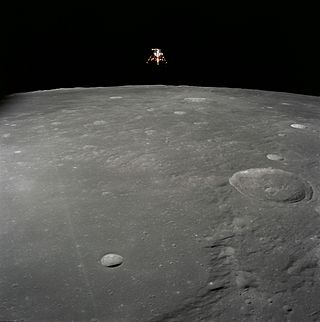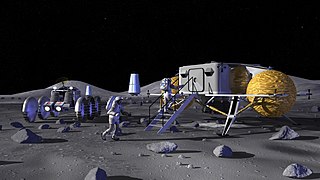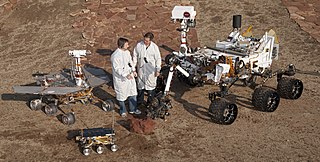Moon
| Mission | Rover | Country/Agency | Date of landing | Coordinates | Operational time | Distance travelled | Outcome |
|---|---|---|---|---|---|---|---|
| Luna 17 | Lunokhod 1 | | 17 November 1970 | 38°14′16″N35°00′06″W / 38.2378°N 35.0017°W | 322 days | 10.5 km (6.5 mi) | Successful |
| First rover on an extraterrestrial body. | |||||||
| Luna 21 | Lunokhod 2 | | 15 January 1971 | 25°51′N30°27′E / 25.85°N 30.45°E | 236 days | 39 km (24 mi) | Successful |
| Farthest distance traveled on the Moon. | |||||||
| Chang'e 3 | Yutu | | 14 December 2013 | 44°07′17″N19°30′42″W / 44.1214°N 19.5116°W | 42 days (mobile) 973 days (total) | 114.8 m (377 ft) | Successful |
| First Chinese extraterrestrial rover and first lunar rover in over 40 years. | |||||||
| Chang'e 4 | Yutu-2 | | 3 January 2019 | 45°26′38″S177°35′56″E / 45.444°S 177.599°E | 1884 days | 1.455 km (0.904 mi) [1] as of 3 January 2023 [update] | Operational |
| First rover on the far side of the Moon.Longest fully functioning rover on the Moon. | |||||||
| Chandrayaan-2 | Pragyan | | 6 September 2019 | 70°54′S22°47′E / 70.90°S 22.78°E | 0 days | 0 km | Precluded |
| Lost when Vikram lander crash landed on the Moon. | |||||||
| Hakuto-R Mission 1 | Rashid | | April 2023 | TBD | 0 days | 0 km | Precluded |
| Sora-Q | | April 2023 | Precluded | ||||
| Contact lost during final descent of the Hakuto-R Mission 1 lander. Presumed crash landing and failure. | |||||||
| Chandrayaan-3 | Pragyan | | 23 August 2023 | 69°22′23″S32°19′08″E / 69.373°S 32.319°E [2] | 12 days | 101.4 m (333 ft) [3] as of 2 September 2023 [update] | Successful |
| First rover to successfully land near lunar south pole . | |||||||
| SLIM | LEV-1 | | 19 January 2024 | 13°18′58″S25°15′04″E / 13.3160°S 25.2510°E | 1 hour and 51 minutes | Successful | |
| LEV-2 (Sora-Q) | Successful | ||||||
| A hopper and a rover included in the SLIM mission which demonstrated precision landing technology. | |||||||
| Peregrine Mission One | Iris | | 2024 | TBD | Precluded | ||
| Colmena x5 | | Precluded | |||||
| Colmena would have been deployed using a small catapult mechanism. Mission cancelled along with the cancelled landing of Peregrine lander due to excessive propellant leak. [4] | |||||||
| IM-2 | MAPP | | H1 2024 | TBD | Planned | ||
| AstroAnt | | Planned | |||||
| Micro-Nova | | Planned | |||||
| Yaoki | | Planned | |||||
| MAPP and Micro-Nova will demonstrate a new lunar communication system. | |||||||
| IM-3 | Lunar Vertex | | H1 2024 | TBD | Planned | ||
| CADRE x4 | | Planned | |||||
| Mission to study Reiner Gamma. | |||||||
| Griffin Mission One | VIPER | | November 2024 | TBD | Planned | ||
| Will land near Nobile crater to search for Lunar water. | |||||||
| Hakuto-R Mission 2 | Micro rover | | 2024 | TBD | Planned | ||
| Hakuto-R Mission 2 will feature a rover for surface exploration and data collection. | |||||||
| LUPEX | LUPEX Rover | | 2025 | TBD | Planned | ||
| Joint mission between ISRO and JAXA. | |||||||
| Chang’e 7 | Chang’e 7 rover | | 2026 | TBD | Planned | ||
| Chang’e 7 hopper | Planned | ||||||
| Will search for water ice in and around craters in the south pole of the Moon. | |||||||
| Starship lunar cargo mission | FLEX | | 2026 | TBD | Planned | ||
| Astrolab contracted with SpaceX to send their rover to the Moon aboard Starship [6] [7] | |||||||
| Chang’e 8 | Chang’e 8 rover | | 2028 | TBD | Planned | ||
| Chang’e 8 Robot | Planned | ||||||
| Chinese ISRU mission in preparation for ILRS. | |||||||










